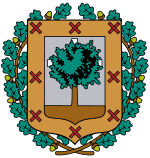Alonsotegi

The churchyard of Alonsotegui (in Basque and officially Alonsotegi) is a municipality in the province of Biscay, Basque Country, Spain. The current name of Alonsotegui was manifest in the 1990s when it separated it from the Baracaldo municipality to which was attached since the end of 19th century. Alonsotegui is approximately 8 kilomenters from the center of Bilbao. Nestled in the valley of the River Cadagua, the churchyard follows the direction of the Road BI-636 ranging from Zorroza to Balmaseda.
With a total length of 16.02 km², its population of 2,831 (INE 2008) is shared between the 3 towns (Alonsotegui (the capital), Iráuregui, and Arbuyo) of the municipality.
Geography
Alonsotegui occupies 20 km². The settlement of the population, as well as the industries, are located in the corridor that the River Cadagua opens between the Sasiburu saw (up to 500 m) and the mountains Ganecogorta (998 m) and Pagasarri (673 m). Several streams have their source on their slopes and bring water to the Cadagua. The center is located at an altitude of 46 m. It borders Baracaldo and Bilbao on the north, Arrancudiaga and Güeñes on the south with, Arrigorriaga and Bilbao on the east, and Güeñes on the west .
History
The history of Alonsotegi is divided into 4 periods:
- Until the late 15th and early 16th centuries, Alonsotegui was part of the municipality of Arrigorriaga.
- In the 16th century, an independent churchyard was established and remained as such until 1888.
- From November 13, 1888 until December 31, 1990, the place remained annexed to the Alonsotegui Baracaldo municipality.
- January 1, 1991, a new and distinct town was delegated in conjunction with the district Iráuregui as Baracaldés.
Places of interest
Alonsotegui has several items of historical, cultural and natural interest:
- Refrigerators of Pagasarri
- Bridge Iráuregui
- The Chapel of San Antolin Iráuregui, San Martin Hermitage, Santa Quiteria Hermitage and Hermitage of Our Lady of The Guide
- Neobasque constructions (such as the working houses of Barrankalea)
- Neo-Gothic buildings such as the Church of St. Bartholomew
- Architectural Elements of ethnographic interest such as the stables and pens in the pastoral neighborhood of Artiba
Municipal elections, 2011
Six parties submitted the lists of the municipality: EAJ-PNV, Bildu, PSE-EE, PP, EB and an independent party called Alonsotegiko Ezkerra. The results were as follows:
| Political Party | Number of votes | % valid votes for candidates | Town councillor |
|---|---|---|---|
| Basque Nationalist Party (EAJ-PNV) | 708 | 41,55% | 5 |
| Bildu (Bildu) | 500 | 29,34% | 4 |
| Alonsotegiko Ezkerra (AE) | 194 | 11,38% | 1 |
| Basque Country's Socialist Party - Euskadiko Ezkerra (PSE-EE) | 173 | 10,15% | 1 |
| Partido Popular (PP) | 68 | 3,99% | 0 |
| Ezker Batua (EB) | 30 | 1,76% | 0 |
This led to winning the current mayor of the town Aitor Santiesteban Aldama.
Illustrious
- Fray Martin de Coscojales, monk
- Fray Miguel de Alonsotegui and Miranda and Jose Zabala, friar
- Inigo Urkullu (1961 -), politician
- Andoni Goikoetxea (1956 -), former footballer and football coach.
- Marcelino Bilbao Bilbao (1920 -), Lieutenant Isaac battalion Bridge of the National Confederation of Labour (CNT) and the People's Republic Army (EPR). Survivor Nazi concentration camp Mauthausen.
External links
| Wikimedia Commons has media related to Alonsótegui. |
- Template:Roto
- alonsótegui.net
- Alonsotegi en méxico
External links
- ALONSOTEGI in the Bernardo Estornés Lasa - Auñamendi Encyclopedia (Euskomedia Fundazioa) (Spanish)
- Alonsotegi's official website
